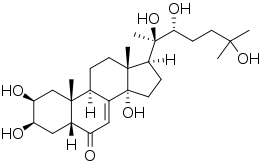Halloween genes
The halloween genes are a set of genes identified in Drosophila melanogaster that influence embryonic development. All of the genes code for cytochrome P450 enzymes in the ecdysteroidogenic pathway (biosynthesis of ecdysone from cholesterol). Ecdysteroids such as 20-hydroxyecdysone and ecdysone influence many of the morphological, physiological, biochemical changes that occur during molting in insects.[1]

Steroid hormones control many aspects of reproduction, development, and homeostasis in higher organisms.[2] In arthropods, steroid hormones play equal or even more vital developmental roles, especially in controlling the patterns of gene expression between developmental stages.[1]
First elaborated by research groups led by Wieschaus and Nüsslein-Volhard in the early 1980s, the name was coined to collectively name a series of Drosophila embryonic lethal mutations associated with defective exoskeleton formation. Early research showed that when one of the Halloween genes was mutated, fly embryos would die before the exoskeleton was created.[3] Mutants in the halloween gene series include the spook, spookier, phantom (or phm), disembodied (or dib), shadow (or sad), and shade genes.
Descriptions
The spook gene (Cyp307a1) is expressed in the prothoracic gland,[4] and in conjunction with the gene product of spookier (Cyp307a2), converts 7-dehydrocholesterol to Δ4-diketol.[3]
The phantom gene (Cyp306a1) encodes an encoding the microsomal 25-hydroxylase. Strong expression of phm is restricted to the prothoracic gland cells of the Drosophila larval ring gland.[5] The gene product converts 2,22,25dE-ketodiol to 2,22dE-ketotriol.[3]
The disembodied gene (Cyp302a1) codes for a cytochrome P450 enzyme that adds a hydroxyl group to the carbon-22 position of 2,22,dE-ketotriol to make 2-deoxyecdysone.[6] dib mutants are defective in producing their cuticle and have severe defects in morphological processes such as head involution, dorsal closure and gut development.[7]
The shadow gene (Cyp315a1) product produces ecdysone from 2-deoxyecdysone.[3]
The shade gene (Cyp314a1) codes for an Ecdysone 20-monooxygenase responsible for adding a hydroxyl group to the 20C-position of ecdysone to make 20-hydroxyecdysone, the final step in the biosynthetic pathway.[8]
References
- Gilbert LI, Rybczynski R, Warren JT (2002). "Control and biochemical nature of the ecdysteroidogenic pathway". Annual Review of Entomology. 47: 883–916. doi:10.1146/annurev.ento.47.091201.145302. PMID 11729094.
- Mangelsdorf DJ, Thummel C, Beato M, Herrlich P, Schütz G, Umesono K, Blumberg B, Kastner P, Mark M, Chambon P, Evans RM (1995). "The nuclear receptor superfamily: the second decade". Cell. 83 (6): 835–39. doi:10.1016/0092-8674(95)90199-X. PMC 6159888. PMID 8521507.
- Gilbert LI. (2008). "Drosophila is an inclusive model for human diseases, growth and development". Molecular and Cellular Endocrinology. 293 (1–2): 25–31. doi:10.1016/j.mce.2008.02.009. PMID 18374475.
- Namiki T, Niwa R, Sakudoh T, Shirai K, Takeuchi H, Kataoka H (2005). "Cytochrome 450 CYP307A1/Spook: A regulator for ecdysone synthesis in insects". Biochemical and Biophysical Research Communications. 337 (1): 367–74. doi:10.1016/j.bbrc.2005.09.043. PMID 16188237.
- Warren JT, Petryk A, Marqués G, Parvy JP, Shinoda T, Itoyama K, Kobayashi J, Jarcho M, Li Y, O'Connor MB, Dauphin-Villemant C, Gilbert LI (2004). "Phantom encodes the 25-hydroxylase of Drosophila melanogaster and Bombyx mori: a P450 enzyme critical in ecdysone biosynthesis". Insect Biochemistry and Molecular Biology. 34 (9): 991–1010. doi:10.1016/j.ibmb.2004.06.009. PMID 15350618.
- Gilbert LI. (2004). "Halloween genes encode P450 enzymes that mediate steroid hormone biosynthesis in Drosophila melanogaster". Molecular and Cellular Endocrinology. 215 (1–2): 1–10. doi:10.1016/j.mce.2003.11.003. PMID 15026169.
- Chávez VM, Marqués G, Delbecque JP, Kobayashi K, Hollingsworth M, Burr J, Natzle JE, O'Connor MB (2000). "The Drosophila disembodied gene controls late embryonic morphogenesis and codes for a cytochrome P450 enzyme that regulates embryonic ecdysone levels". Development. 127 (19): 4115–26. PMID 10976044.
- Petryk A, Warren JT, Marques G, Jarcho MP, Gilbert LI, Kahler J, Parvy JP, Li YT, Dauphin-Villemant C, O'Connor MB (2003). "Shade is the Drosophila P450 enzyme that mediates the hydroxylation of ecdysone to the steroid insect molting hormone 20-hydroxyecdysone". Proceedings of the National Academy of Sciences of the United States of America. 100 (24): 13773–78. doi:10.1073/pnas.2336088100. PMC 283497. PMID 14610274.